10 Best Day Trips from Cusco: Explore Inca Ruins, Scenic Hikes, and Machu Picchu

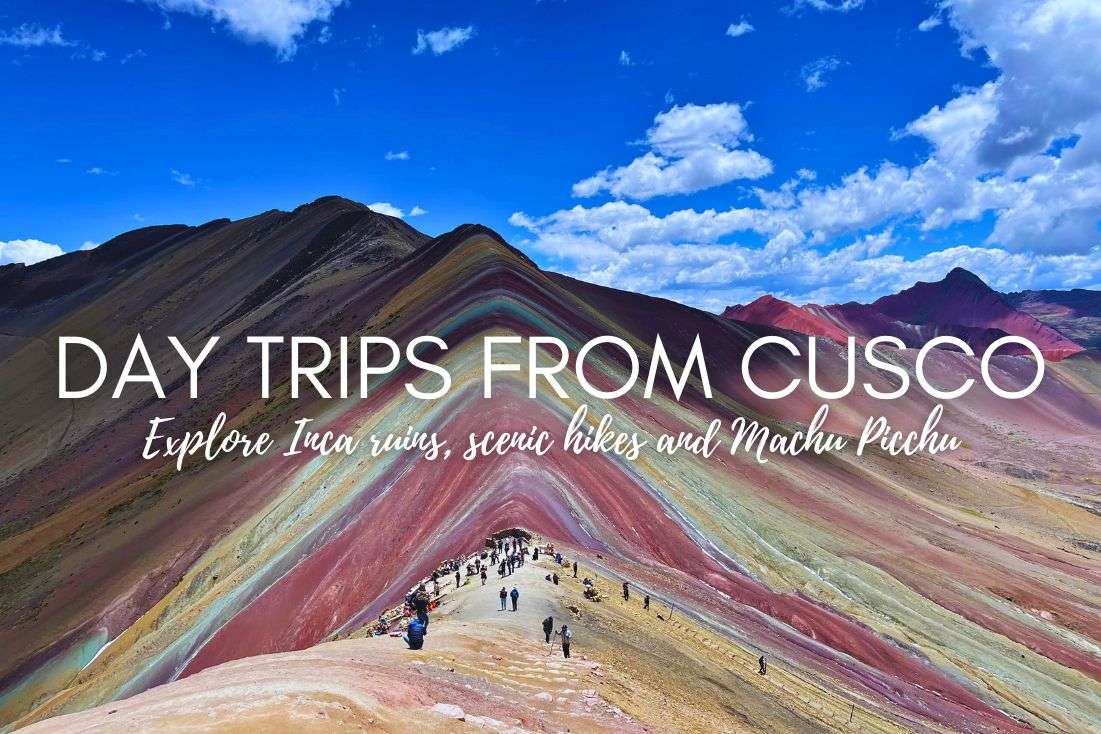
These day trips from Cusco aren’t just little side-quests to pass the time; they’re full-blown adventures that rival the city itself in beauty and cultural significance. And bonus points for DIY travelers like me: all of these exciting trips are easy to visit independently!
From stunning Inca archaeological sites in the Sacred Valley to turquoise lakes and the colorful Rainbow Mountain, there are more day trips from Cusco than most itineraries can fit. While Machu Picchu is the main draw, you'll soon discover that Cusco itself is a treasure trove of adventure… and that you need more than a day for Machu Picchu.
As Peru's historical capital, Cusco’s rich Inca heritage and breathtaking landscapes keep travelers coming back for more. Whether it’s because it has kept its Inca traditions more than any other city, or because you just can’t beat the setting, people are visiting for a day and staying for a week in the former Inca capital.
A quick list of the top Cusco day trips:
- Machu Picchu: Better as an overnight trip
- Rainbow Mountain
- Humantay Lake
- Ollantaytambo
- Pisac Inca ruins
- Moray Incan ruins and Maras salt mines
- Chinchero village
- Ausangate trek (multi-day)
- Salkantay trek (multi-day)
- Lake Titicaca? Not a chance!
Sometimes, all you need to do is take the first step... I've filtered out the best hotels in Cusco for you
Save it for yourself to come back to later, or share with your friends on social media!
I've already planned your ititnerary for the trip, complete with my travel tips.
Cusco day trips: Map of where to go and where to skip
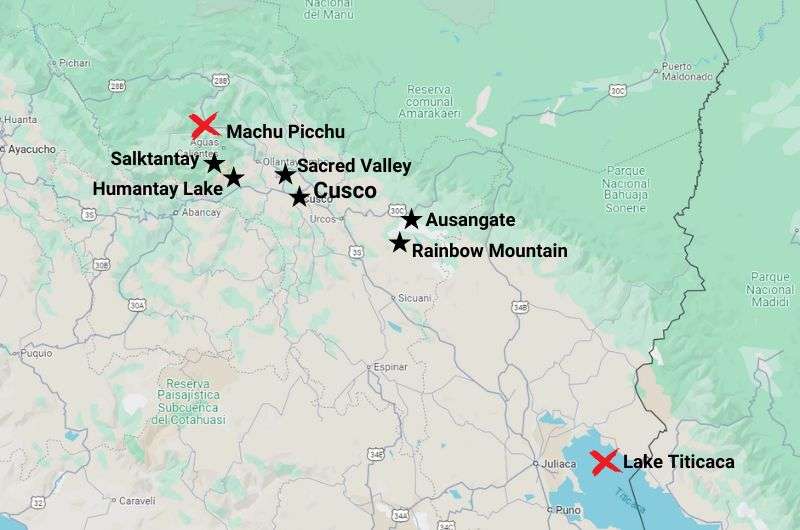
These are the top day trips from Cusco. Notice Machu Picchu and Lake Titicaca aren’t recommended!
My top tips for day trips from Cusco:
- Get your tickets: There’s such a thing as the Cusco Tourist Ticket that includes many of the spots you’d like to see one your day trips from Cusco. They can only be bought in person. Read details about it in my Sacred Valley article.
- Driving saves time and sanity: Renting a car gives you freedom and flexibility, which I greatly appreciate and always go for when traveling. You can also pay for a driver for the day.
- Time saver: A lot of the places in Sacred Valley can be connected into a single day trip—you don’t need a full day for each. Set out early in the morning and make it a big loop drive.
- Use your saved time for Machu Picchu: Machu Picchu requires at least one overnight to give the most famous Inca site in the world proper time. See my Machu Picchu article for all the details on planning a visit (it’s harder to plan than you’d think!).
- Avoid mountain sickness: Stay in Cusco and surrounding areas for at least 4–5 days before heading out on any of the longer mountain treks or to Rainbow Mountain (5,036 m (16,522 ft) is no joke!).
- Spoil yourself: If you’re on the hunt for some special hotel experiences, Sacred Valley is the place to splurge. Check out Vertical Sky Luxury Suites—the next-level-est. They ain’t lying when they call it “vertical”!
1. Machu Picchu: a must-do after your Cusco city tour!
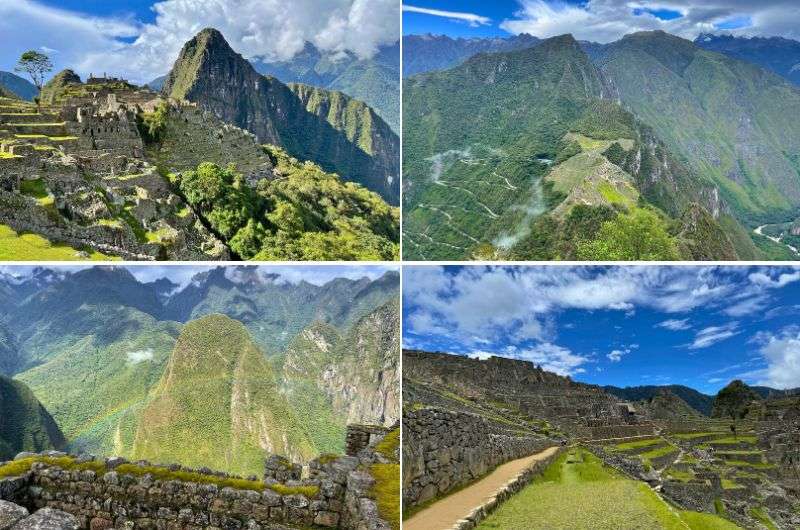
Machu Picchu is a must-do day trip from Cusco! These photos were taken in the rainy season
- Distance from Cusco: 60 km (38 miles) to Ollantaytambo (1.5-hour drive), then 1.5 hr train to Aguas Calientes and a 20-minute bus to Machu Picchu
- Time spent there: At least one full day—an overnight is inevitable if you want to see it properly
- Pro tip: There are different visitor circuits at Machu Picchu, and I suggest you go on 2 separate days to different ones for the ultimate tour (read my BIG Machu Picchu guide for details).

The Inca city of Machu Picchu doesn’t need much introduction, you’ve all seen the photos. Machu Picchu are the ruins of a massive Inca city that was built atop a mountain with phenomenal views. And it’s not easy to get to, either, adding suspense, adventure, and a whole lot of spending on transportation to actually be able to witness Machu Picchu with your own eyes.
Is visiting Machu Picchu a day trip from Cusco? No!
There’s just too much logistics involved to get to Machu Picchu for you to be able to go there and back in one day comfortably. If you’re hoping to see the sunrise at Machu Picchu, then it’s a double no. There’s just no way.
You will want to overnight in either Ollantaytambo or in Aguas Calientes, the town under the mountain with the Inca city on top of it.

How do I get to Machu Picchu from Cusco?
In a nutshell, to get to Machu Picchu, you’ll be driving for about 1.5 hours from Cusco to Ollantaytambo (or taking another, slower mode of transportation), getting on a 1,5-hour train from Ollantaytambo to Aguas Calientes, and a 20-minute bus from Aguas Calientes to Machu Picchu Inca city.
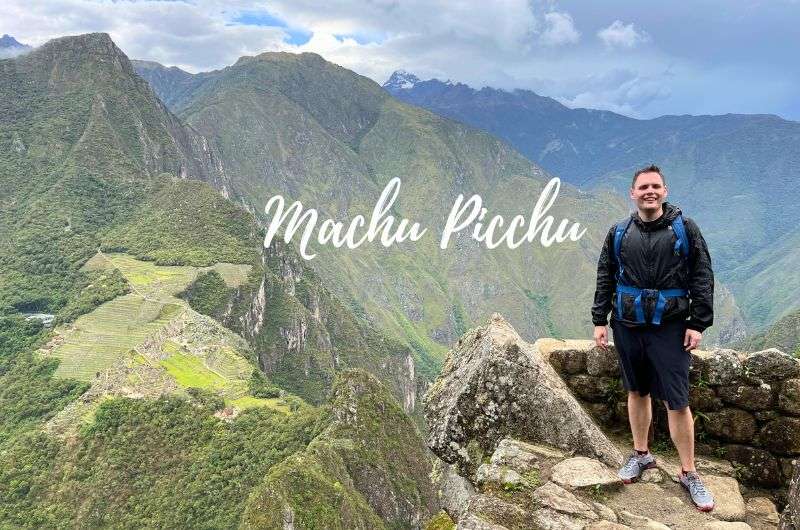
3 hours and 20 minutes from Cusco is this gem that millions of people from all over the world flock to admire (sorry, I won’t be there, but it’ll still be nice)
Plus, you have to account for time to buy bus tickets, getting to and from train and bus stations and waiting for an empty bus, too. All that will take half a day and you haven’t even entered Machu Picchu yet!
You’ll also need to purchase your tickets to Machu Picchu up to 6 months in advance—that is if you’re visiting in high season—June to August—, and you can choose from several ticket combinations of the Inca city visit + one of three hikes to surrounding mountains.
The hike we took, Huayna Picchu, was certainly steep, narrow, and a little hair-raising, but how else do you want to get those views of Machu Picchu?! Again, see our full Machu Picchu guide for details on the individual hike options.
2. Rainbow Mountain
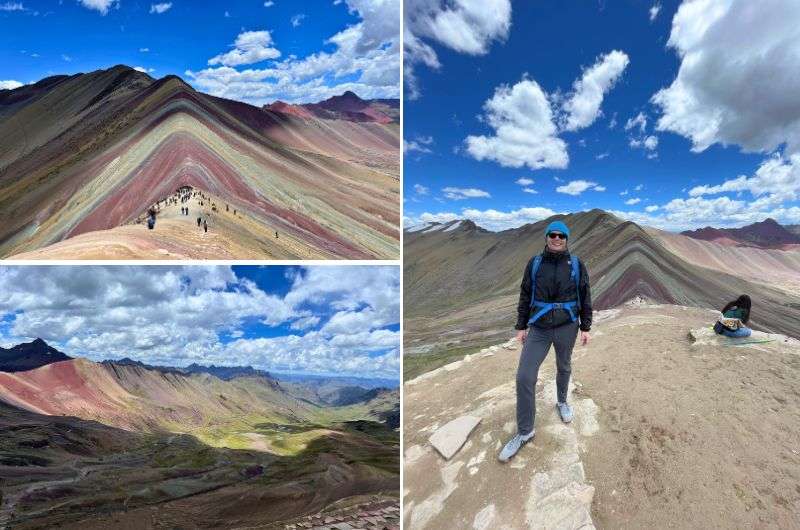
Visit Rainbow Mountain... look at me smile through my mountain sickness like a pro!
- Distance from Cusco: 140 km (86 miles), about a 3-hour drive
- Time spent there: 3.5–4.5 hours depending on your fitness level, trail you take, and how sick you feel (I had bad mountain sickness and so did about 50% of all others I met)
- Pro tip: There are lovely ladies selling coca tea on the trails and that helps a little. Spend at least 3 days in Cusco before you attempt Rainbow Mountain to acclimatize to the whopping 5,200 m (17,060 ft) above sea level.
A fantastic Cusco day trip that is doable in a single day, but only after proper acclimatization in Cusco and Sacred Valley, is Rainbow Mountain. The mountains have colorful stripes based on the mineral that prevails in whichever stripe, though they aren’t as bright as Instagram wants you to believe. Is #nofilter still a thing? It should be, at least for natural sites.
That’s ok, because yes, it is wonderful seeing a colorful mountain, but the challenge of even getting there and the incredible scenery is what it’s all about. One look at snow-capped, 6,300 m (21,000 ft) sacred mountain Ausangate in the distance and you’ll be happy you took the trip.
What to expect on the hike to Rainbow Mountain
It may look all cute and stripey, but the main hike starts at an altitude of 4,600 m (15,000 ft) and continues for 3 km (1.8 miles) with a total elevation gain of about 400 m (1,300 ft). Read up on mountain sickness (AMS) beforehand and don’t underestimate it! We had a hard time with the altitude and ate and drank enough coca for a whole Inca village and still had terrible headaches and nausea.
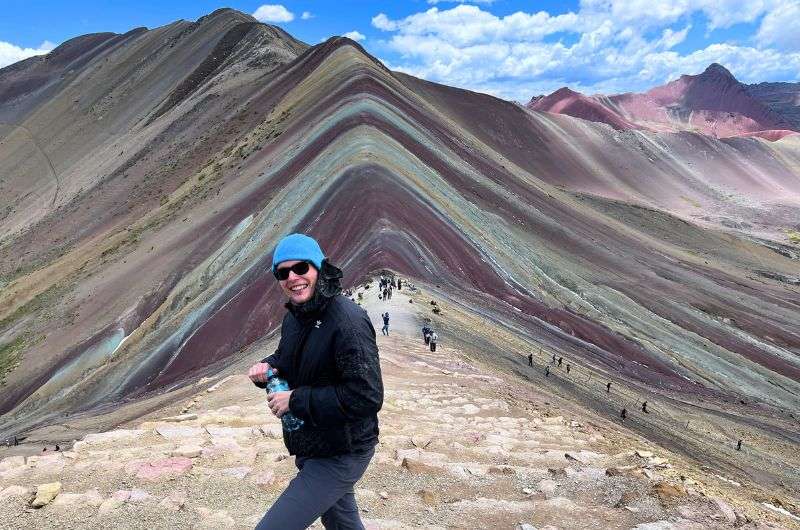
Me, visiting Rainbow Mountain. Stay hydrated!
The Rainbow Mountain, Vinicunca, is not the only rainbow-colored mountain around. In fact, there are many of them in the area, like Palccoyo, which is much easier to hike. There are two basic routes to Rainbow Mountain (Vinicunca), and the Palccoyo alternative.
The drive from Cusco to all of the starting points takes 3–4 hours.
The most popular Cusipata trek to Rainbow Mountain will have you sharing the trail with dozens of other tourists, most fighting their own personal fight with altitude sickness, chewing coca leaves, drinking coca tea, and smiling through the pain while taking millions of photos.
It’ll take about 2 hours one way. The hike itself would be an easy to medium-level hike, but that factor of not enough oxygen turns it into a hard one.
A secret alternative to Rainbow Mountain: Palcoyyo
For a much easier way to see some rainbow-colored mountains, check out the Palcoyyo alternative route. It doesn’t take you to the Rainbow Mountain, but you still see not one but three similarly striped mountains just a little ways away. And the hike only takes 40 minutes.
I have a whole article with details on all of the options to see Rainbow Mountain, along with route information, prices and tips on extra add-ons to each hike:

3. Humantay Lake day trip
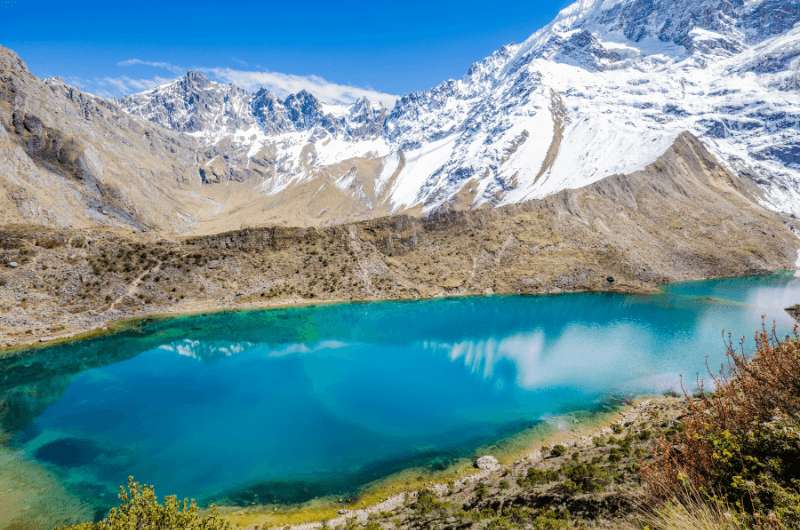
Green-blue Lake Humantay
- Distance from Cusco: 120 km (76 miles), about a 3-hour drive
- Time spent there: 2 hours for the hike itself, most of the day to drive there and back
- Pro tip: In case you do encounter shortness of breath, there are mules waiting along the way, ready to take you to the lake for a small fee.
You won’t be able to stay in Cusco without seeing offers to visit the stunningly green-blue Lake Humantay. It’s a gorgeous lagoon located under snow-capped Salcantay Mountain, bordered by luscious green hills. This is one of the most popular Cusco day trips that most people undertake as part of a group tour.
The hike is medium difficulty, mainly because of how steep it is and the chance of mountain sickness. The starting altitude is 3,800 m (12,460 ft) at the trailhead in Soraypampa and the lake itself is at 4,200 m (13,780 ft), so the elevation gain is quite substantial over the short trek. You really want to spend a few days in Sacred Valley and Cusco before heading up any higher to allow for your body to get used to the thinner air.
Read more about Acute Mountain Sickness.
The 2.6 mile loop hike will take you about 2 hours to complete, so it isn’t terribly long. You do need to remember that this is doable as a day trip from Cusco, but it’s still a 3-hour drive one way.
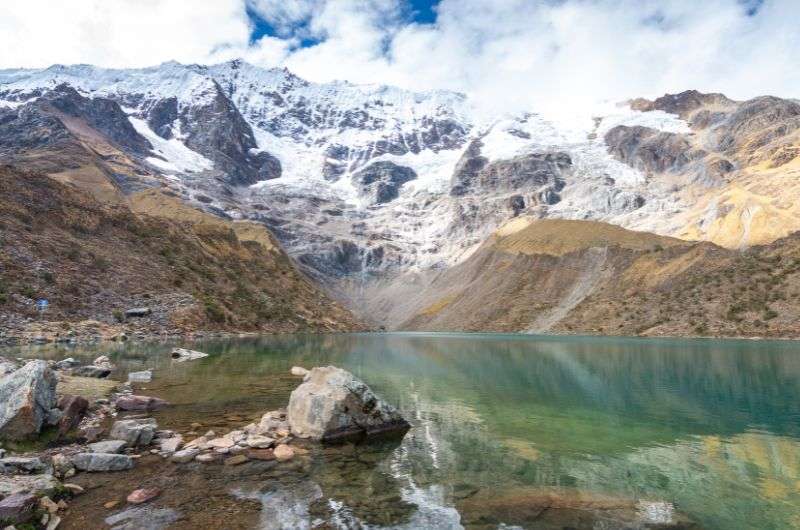
You can visit Humantay Lake without a guide
Some people opt to hike all the way up to Salcantay, and Humantay Lake is one of the stops on that hike. For going just to Humantay, you really don’t need a guide, since the trail is clearly visible, and you’ll get to the lake in about an hour.
There are tour groups going up to Humantay Lake daily from Cusco. Most of them start picking people up at their Cusco hotels at 3 am, making it to the trailhead after the 3-hour drive in the early morning. Take that into consideration if you’re going on your own and plan on arriving later than everyone else so you aren’t stuck in foot traffic on your way up the mountain.
The entrance fee to Humantay Lake is s/10, payable in cash at the checkpoint in Mollepata.
4. Ollantaytambo Inca ruins and town
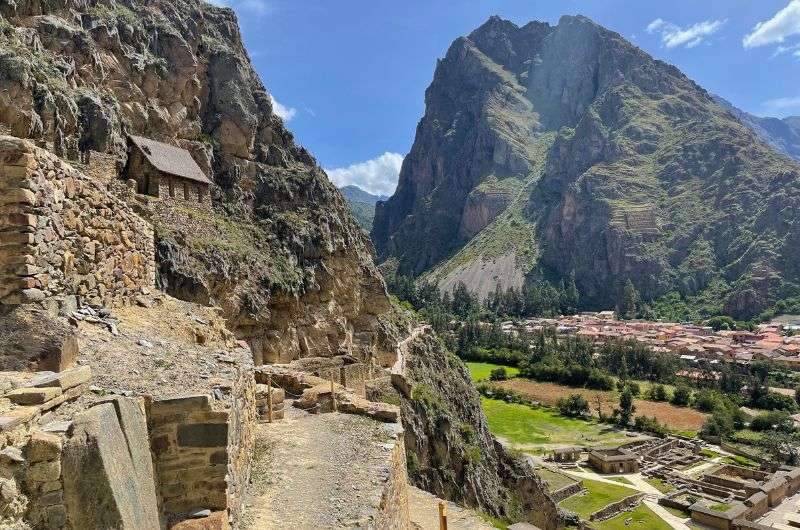
Ollantaytambo ruins
- Distance from Cusco: 60 km (38 miles), a 1.5-hour drive
- Time spent there: 3 hours minimum to see the Inca ruins and the historic town center around Plaza de Armas
- Pro tip: I recommend spending an afternoon in Ollantaytambo before overnighting there and hopping on the train to Machu Picchu in the morning.
Most people visit Ollantaytambo as the starting point of their trip to Machu Picchu, since this is where where you get on the train to go to Aguas Calientes, but there’s much more to it than that!
Did you know? Sacred Valley, the heart of the Inca Empire, is the roughly 60 km (37 mile) section around the Urubamba River between Pisac and Ollantaytambo towns, cut deep into the majestic Andes Mountains. Conveniently on Cusco’s doorstep, you come here for the Inca ruins and some majorly stunning scenery.
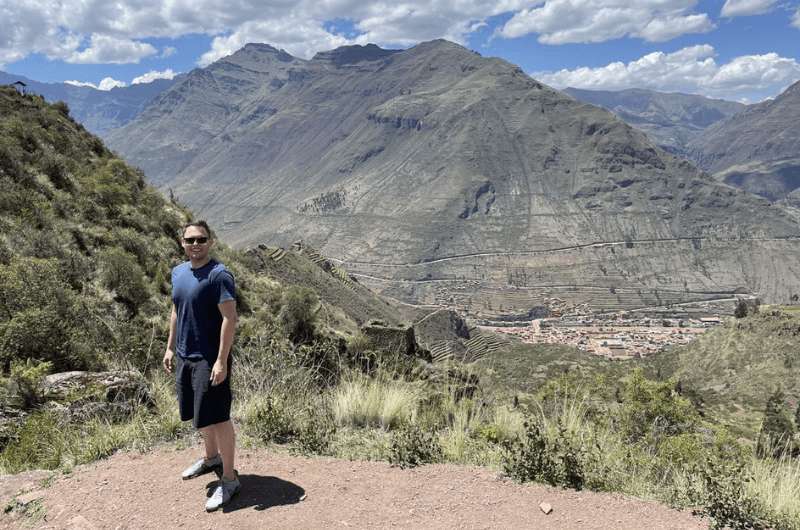
Spending time in Sacred Valley
The Inca ruins at Ollantaytambo are some of the best preserved in all of Peru. They’re huge, probably more expansive than the ones at Machu Picchu. The ruins at Ollantaytambo copy the mountain terrain, so you’ll be doing quite a bit of climbing up and down. But you know what climbing up gets you? Views!
Just like the terraces at Moray, the sunken terraces at Ollantaytambo were used for growing crops that would’ve otherwise not grown at this altitude.
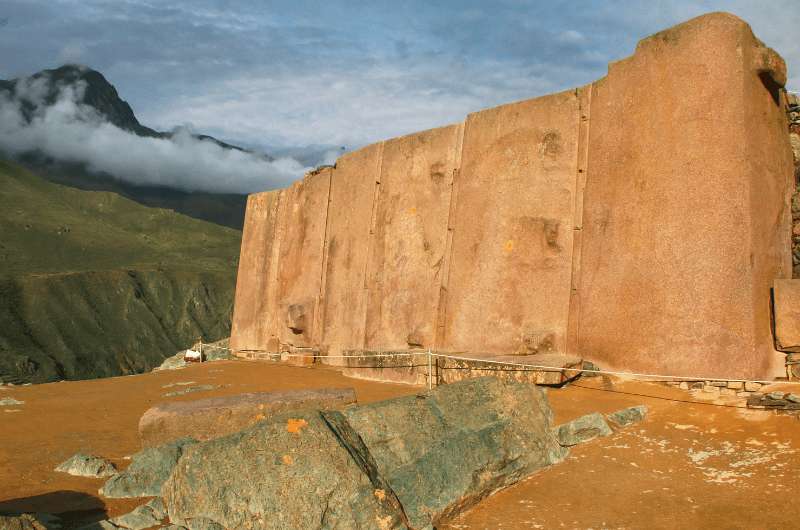
The Wall of the Six Monoliths—how did they get those rocks there?!
Ollantaytambo is about 1 hour 20 minutes away from Cusco by car through Sacred Valley. We always rent our own set of wheels to allow for maximum comfort and flexibility.
Since Ollantaytambo was a full-on Inca city, you can also find storehouses, quarries and defense walls, letting you wonder how the Incas worked with such huge slabs of stone. The stones for the Wall of the Six Monoliths had to be moved 6 km (3.7 miles) from a quarry on a mountain on the opposite side of the river. Say what?! They didn’t use the wheel, so how did they do it?!
The Ollantaytambo ruins are just a 5-minute walk from the main plaza, Plaza de Armas. A visit will take you 2 hours.

5. Pisac Inca ruins and town
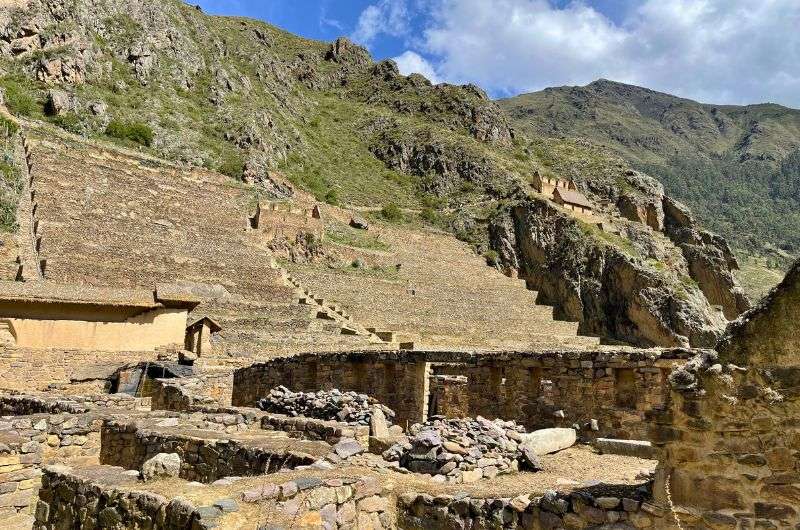
Pisac Inca ruins
- Distance from Cusco: 35 km (22 miles), a 1-hour drive
- Time spent there: 2 hours
- Pro tip: Lots of people go to the Pisac weekend market, but I found it very touristy and underwhelming. The one in Chinchero is much better.
Pisac is a former Inca fortification that sits at about 3,000 m (9,800 ft), so it’s like you’re getting views of the views of Sacred Valley, and they’re phenomenal. Honestly, it’s the ruins that you’re supposed to come to Pisac for, but it’s the views that you’ll remember. They’re second only to Machu Picchu itself.
Pisac probably served as protection for the Sacred Valley from the east, just as Ollantaytambo guarded it from the west.
What else is there to do in Pisac?
Besides the Inca ruins, you also have the chance to visit Pisac town itself with its very own Plaza de Armas (basically every main square in Peru is called Plaza de Armas!) and get a glimpse at rural life in Peru. Pisac is very popular with tourists, so it’s not like you’ll be getting a candid view, but it’s pleasant nonetheless, plenty to keep you busy for a half day tour.
If you want to see the Sunday market, go with adequate expectations—it has become very much geared towards tourists, with many stalls selling souvenirs. Of course, you will also see the ladies from nearby villages selling their handicrafts, it’s just that you and other fellow travelers will make up the majority of visitors.
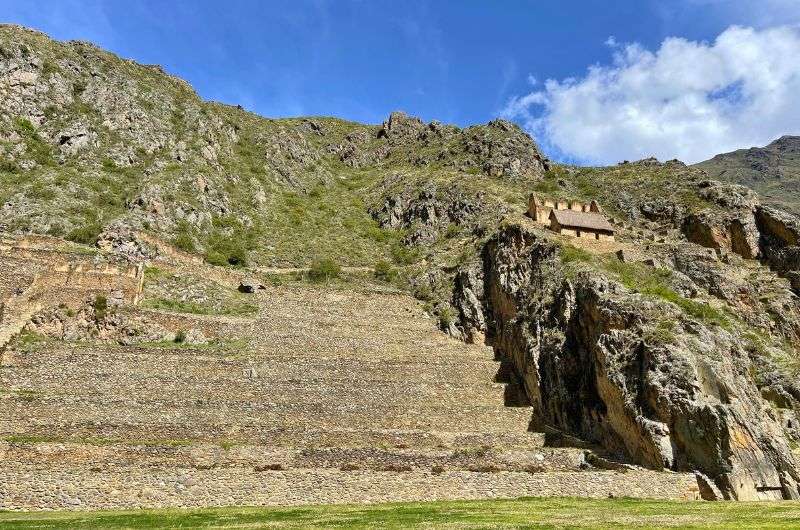
The Pisac ruins are located an hour drive from Cusco—easy to visit in half a day
Where are the Pisac ruins located?
The ruins are not in Pisac town directly. The Pisac archeological site is about 3.5 km (2.2 miles) north of town, so it’s best to have your own car or at least a driver for the day to take you. Otherwise, you can take the 2-hour trek out of Pisac town on your own two feet.
The drive from Cusco to Pisac is about an hour long. Pisac is included in the Cusco Tourist Ticket.
For a more traditional market experience, stop by Chinchero instead.
You’ll need 2 hours at the ruins in Pisac. Add on time for the town if you want to have a little extra wander.
6. Moray agricultural lab and Maras salt pools
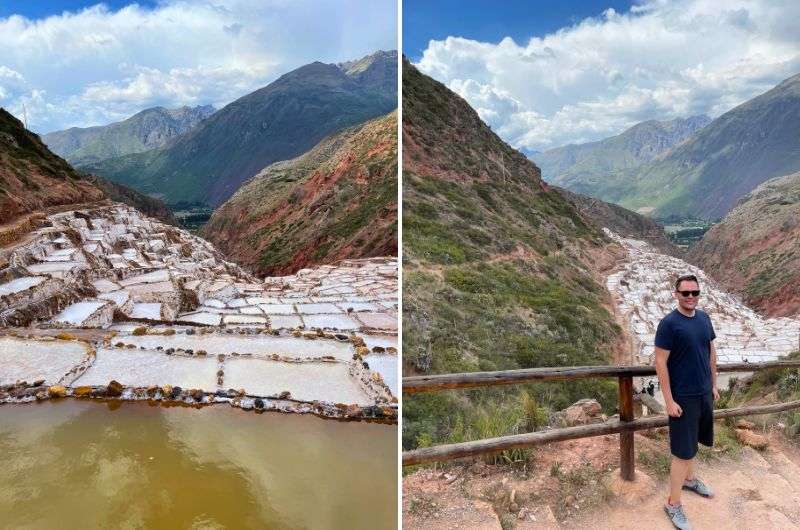
Maras salt mines with pools of salty water
- Distance from Cusco: Maras is 41 km (25 mi) away, a 1-hour drive from Cusco. Moray is another 10 minutes away from Maras.
- Time spent there: 1 hour total for both places + driving time
- Pro tip:
Moray and Maras in Peru are like stepping into the brilliance of the Inca mind—Moray's mesmerizing circular terraces reveal their agricultural genius, while the shimmering salt ponds of Maras are a stunning testament to nature's collaboration with human creativity.
Visiting the Maras salt mines
Maras is a whole side of a mountain filled with thousands of salt evaporation pools. The Incas are to thank for the construction of the site, though it is actively being used to mine salt by local families to this day.
There’s a salty underground stream that runs through the area, and the Incas learned to gather the water and evaporate it on the sunny slopes of the mountain, leaving them with layers of yummy, salty goodness. They look like white rice terraces, and when you visit, you might even get a glimpse of locals working away on their plot.
You aren’t allowed to walk through the salt fields, but there are viewing platforms and walkways that take you to several different levels, so you still get a good look.
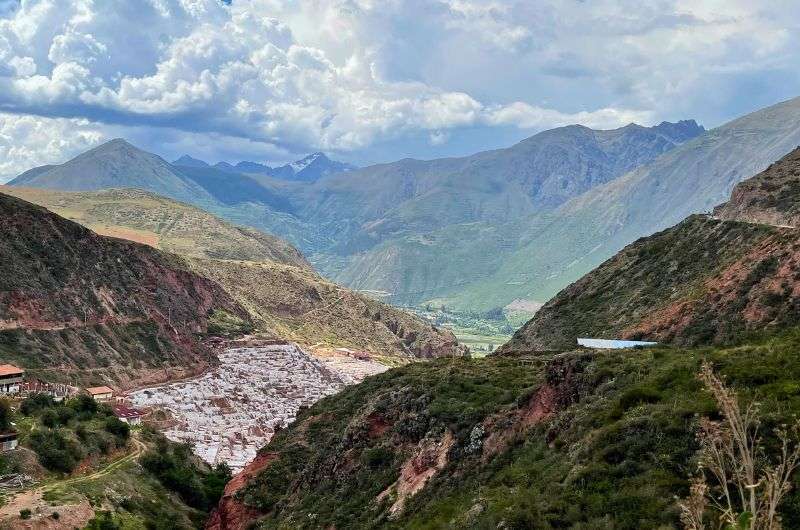
Maras city
Set aside 30 minutes for a visit to Maras.
Visiting Moray’s circular terraces
Moray used to be the Incas’ experimental agricultural laboratory. The Incas were researching which plants grow best in which microclimate by creating a round, terraced depression, taking into account the direction of the sun and wind, and growing different crops on the individual terraces.
The difference in temperature between the top and bottom levels was 5°C (9°F), and soil from different parts of Peru was brought in to mimic different conditions on different levels, allowing them to suss out which microclimate works best for whichever crop. Super cool, right?
There are 3 different terraced, circular, erm, holes, at Moray. The diameter of the largest inner circle is 180 m (600 ft). You can walk around, climb up and down, and take in the Incas’ ingenuity and the scenery all at once.
Allow 30 minutes to an hour for your visit.
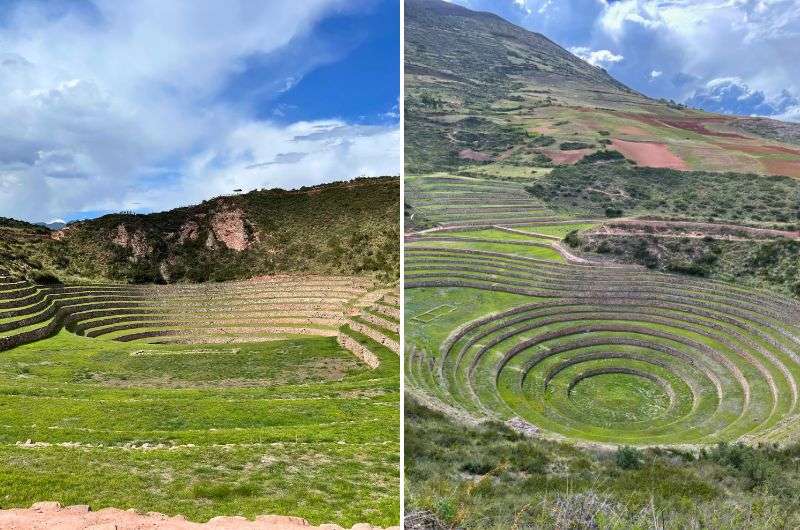
Moray experimental agricultural lab
Logistics of this day trip
The two sites of Moray and Maras are right next to each other, so it's like two destinations in one. It takes about 20 minutes to drive between them because of the road conditions (dirt roads). Easy to visit as one of your Cusco day trips, the drive from Cusco to Moray and Maras takes 1 hour.
Tickets to Maras can be bought at the entrance for PEN 10 (USD 2.60). Moray is part of the Cusco Tourist Ticket.

7. Chinchero village
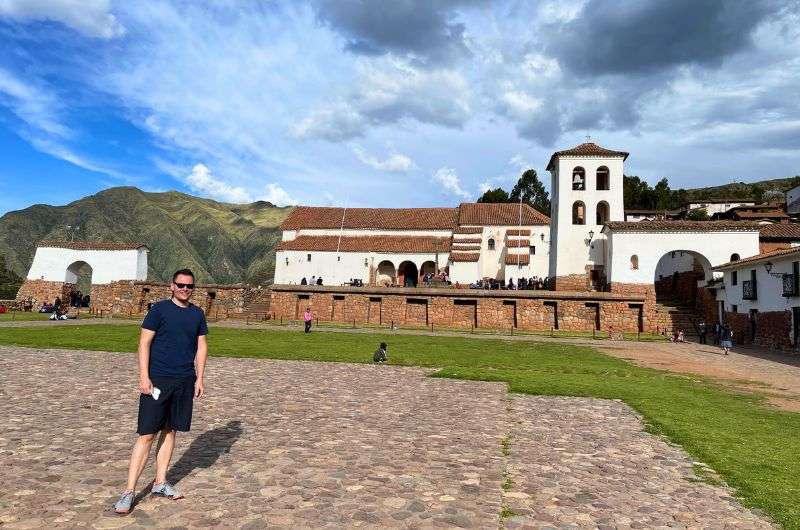
Isn’t it cute? Not exactly an exciting tour, but a charming one for sure
Distance from Cusco: 30 km (19 miles), a 45-minute drive
Time spent there: All day
Pro tip: Go on a Sunday if you want to see the vibrant market. Go on any other day and still find plenty of places to shop for souvenirs!
More Inca archaeological sites, anyone? No problem! This time, you might even get them all to yourself. And you’ll probably leave with a new sweater. Another popular stop from Cusco is cute little Chinchero town.
Go there to experience classic Peruvian vibes—people here still wear traditional dress as they go about their business. Visit on a Sunday and visit the vibrant Sunday market. The Quechuas are known for their weaving techniques, so go ahead and buy some souvenirs! You can also take weaving classes.
Or check out the colonial church in Chinchero. It was built on the foundations of an Inca temple. You’ll notice that many buildings throughout Sacred Valley and Cusco have a bottom layer made of stones—that’s the Incas heritage that was built on by the Spaniards.
The terraced Inca ruins at Chinchero are way less popular than others in the Sacred Valley, so you just might have them all to yourself, which can feel very mystical.
Do you like horseback riding? There are many companies that offer single- or multi-day trips on the back of a horse. Isn’t there a saying about the world seeming more beautiful from the back of a horse? I don’t know, I’m allergic to them, but I wanted to put this option out there for the majority of you that don’t puff up when within a 3-meter radius of a one.
8. Ausangate trek (4–6 days)

Ausangate mountain
- Distance from Cusco: 115 km (71 miles), a 3-hour drive to Tinki, a small town near the trailhead
- Time spent there: 4–6 days
- Pro tip: You can do this trek on your own, but having a guide feels like the safer option.
The Ausangate trek is a beast of a journey and one heck of an exciting trip, set against the backdrop of the highest mountain in the Cusco region, towering over 6,300 m (21,000 ft). Ausangate has been a place of worship since before the Incas, and even today, it's considered sacred. In May, thousands of pilgrims gather to honor the mountain spirit during the Qoyllur Rit’i Festival.
This trek isn’t for the faint-hearted—it’s 66 km (40 miles) of raw, rugged beauty, with passes over 5,000 m (16,400 ft), including the steep Arapa and Palomani passes. Expect 4–6 days of serious hiking, so beginners beware.
And the weather? Let’s just say you might want to be prepared for a surprise blizzard or two. Bring your layers! But also, bring your SPF—you’ll be closer to the sun than your skin feels comfortable with.
Getting to the Ausangate trailhead
The trek kicks off in Tinki, a tiny town about 3 hours from Cusco. Along the way, you’ll pass stunning blue-green lakes, meet cheeky llamas, and encounter remote communities where locals still live simply, without electricity, herding their animals just like they have for generations. It’s truly memorable to cross paths with them. And the surrounding mountain views will stop you in your tracks.
Beware of altitude sickness
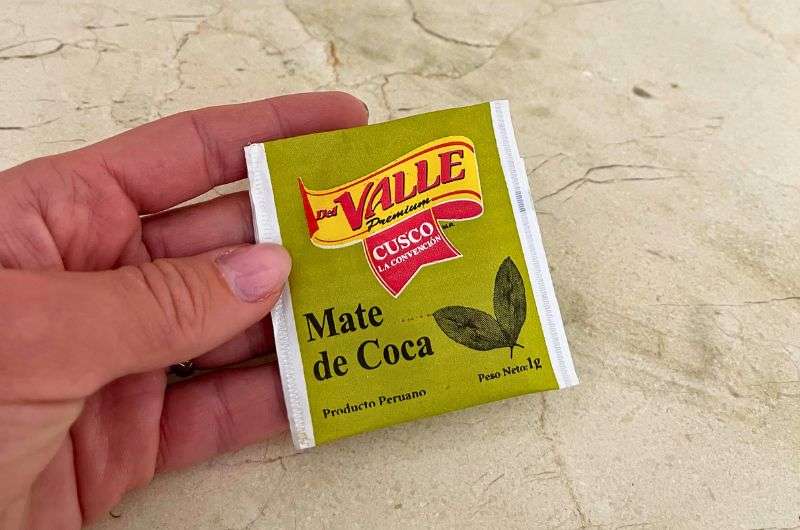
This can actually help with altitude sickness
Now, a word of caution—altitude sickness can bring you to a standstill if you’re not prepared. Make sure to acclimatize in Cusco or the Sacred Valley for at least 4 days before hitting the trail. We only took 2 before tackling Rainbow Mountain and, well... let's just say it was a New Year’s I won’t forget anytime soon.
Speaking of Rainbow Mountain (Vinicunca), you’ll pass it along the Ausangate route, but aside from that high-traffic spot, it’s just you, the trail, and the mountains. Trekking poles are your best friend here—both for balance and keeping overenthusiastic herd dogs at bay. Some tour companies even offer horses to carry your gear (or you, if you’re feeling the burn).
While you can do the Ausangate trek on your own, I’d recommend going with a guide for peace of mind on such a long trip. Check out reviews online to find a good fit. A 5-day, 4-night guided trek typically runs around USD 500.
Tip: I’ve done quite a bit of hiking on my trips. Check out our articles about Torres del Paine in Chile or Itza Popo National Park in Mexico.
9. Salkantay trek as an alternative to the Inca Trail (4–6 days)
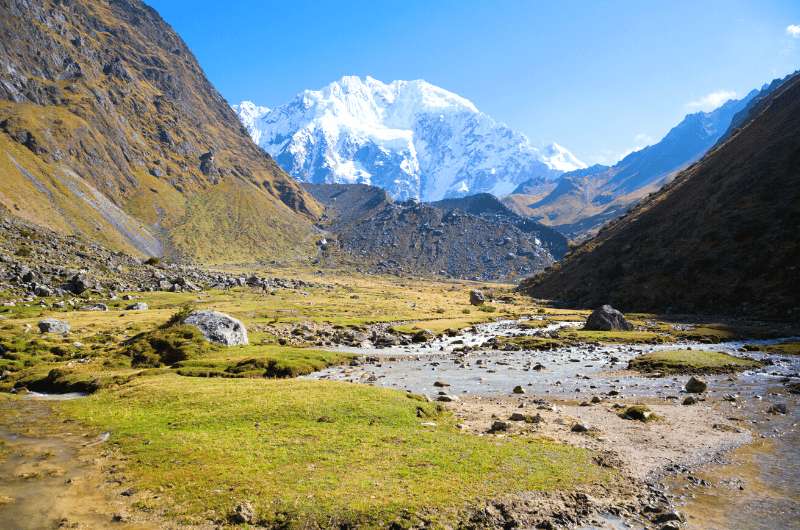
Salkantay trek views
- Distance from Cusco: 100 km (60 miles), a 2.5-hour drive to Mollepata, a small town near the trailhead
- Time spent there: 4–6 days
- Pro tip: This is how you walk to Machu Picchu if you want to avoid the crowded Inca Trail.
The Salkantay trek is often seen as an alternative to the Inca Trail, but it’s good to know that it is quite a bit more demanding. It is a 4–6-day adventure that’ll take you 75 km (45 miles) from Mollepata village to Aguas Calientes, which is the town right under Machu Picchu itself.
Preparing for Salkantay Pass
The trek’s highest point is the Salkantay Pass at 4,600 m (15,000 ft), and the average altitude is 3,000 m (9,800). Read up on altitude sickness, this is not a trek that you go on in a whim. Be sure to acclimatize in Cusco or Sacred Valley (or another higher-altitude area, like Colca Canyon) for at least 4 days before setting out on the Salkantay Trail. People actually train for this route, so take it seriously.
You usually get to the Salkantay Pass on the second day of the trek and it’s almost all downhill from there. So, start strong, get to the highest heights and then it’s smooth sailing from there. You will be clambering down on loose rocks a big chunk of the way, so not that smooth.
Thanks to the variations in altitude on the trek, you’ll see your surroundings change, too. Sometimes find yourself in a lush jungle, and sometimes you’ll be walking through a cloud forest surrounded by sharp rocks.
Bonus sights: You’ll also pass Humantay Lake!
Along the trail, you’ll also get to see Humantay Lake as well as some hot springs. For those, you can not only look but also touch, by which I mean jump in! It’s great on tired legs. You could theoretically jump into Humantay too, but you’d be darn cold if you did.
Tip: Walking sticks are a great help for downhill routes such as this one. Also, insect repellent! There are sandflies that’ll try to eat you alive.
Remember that this route doesn’t end with you walking into Machu Picchu like a king. You get to Aguas Calientes, which is where you have to take the 20-minute bus up the mountain to the actual Inca city. You can also walk up there, but you’ll be walking on the narrow road with all the buses, which isn’t exactly wonderful.
Read my full guide to visiting Machu Picchu for all the details.

You can connect the Salkantay trek with Humantay lake sightseeing
Make sure to bring proper gear
Weatherise, it all depends on what altitude you are at, but the only spot that is any real concern is the actual Salkantay Pass, where freezing temperatures are the norm. In other parts of the trail the days are usually a mild 20°C (70°F), with cooler nights.
That said, only set out on this hike with proper hiking and camping gear and clothing and be ready for the weather to change. One minute there could be blistering sun and the next minute there’s a snow storm.
No permits needed for the Salkantay trek
If you opt for a guided tour, book it as soon as you know your travel dates, ideally a couple of months in advance. But unlike the Inca Trail where you need to book 6 months in advance if you want to go on the trek, Salkantay is more forgiving. Even a few weeks beforehand you’ll still be able to find someone to take you.
No permit is needed on the Salkantay Trail, and you can even set out on your own if you dare.
The Salkantay trek is more difficult than the Inca Trail, making it also less popular, which can be a positive aspect for some. No crowded paths to Salkantay!
Sometimes, all you need to do is take the first step... I've filtered out the best hotels in Cusco for you
Save it for yourself to come back to later, or share with your friends on social media!
I've already planned your ititnerary for the trip, complete with my travel tips.
10. Day trip from Cusco to Lake Titicaca? Not realistic
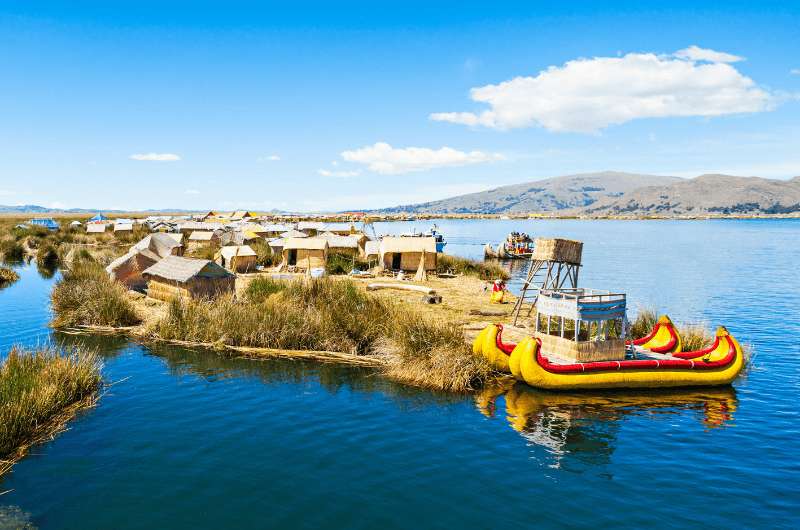
Lake Titicaca
- Distance from Cusco: 387 km (240 miles), a 6-hour drive to Puno
- Time spent there: 1 night at the very least
- Pro tip: If you decide to come all the way to Lake Titicaca, I strongly suggest staying on the lake itself in one of the traditional reed houses. (There are some with modern amenities.)
You can’t call Lake Titicaca a day trip from Cusco by any stretch of the imagination, but we’re putting it on the list since it comes up repeatedly in searches. The drive to Lake Titicaca is 6 hours long, so unless you want to spend literally all day and part of the night in a car, you need to treat Lake Titicaca as an overnight destination.
Lake Titicaca is the highest-altitude large lake in the world at 3,800 m (12,500 ft), and one of the most iconic natural wonders in South America. It is 190 km (120 miles) long and 80 km (50 miles) wide and up to 280 m (920 ft) deep. It is located on the border of Peru and Bolivia, with the border line running right through the middle of the lake.
By legend, the supreme Inca god, Viracocha, emerged from the lake and created the sun, the moon, the stars, and the first Inca king, Manco Capac, and Mama Ocllo, who then went on to create the Inca Empire. As such, there is a huge amount of Inca ruins around (and in!) Lake Titicaca and it is considered the birthplace of the Inca culture.
Today, Puno is the central port of the lake and is called the folklore capital of Peru, renowned for its music and dance. The Festival of the Virgin of Candelaria is held every February and is one of the largest festivals in all of South America. 18 days of shows and parades showcase the best dancers and musicians in elaborate, colorful costumes.
Who are the Uros people?
Lake Titicaca isn’t just a pretty big lake that you can come look at. You can also go and stare at the indigenous tribes that live on the lake. There are natural islands on Lake Titicaca, but the most fascinating are the manmade islands of the Uros people.
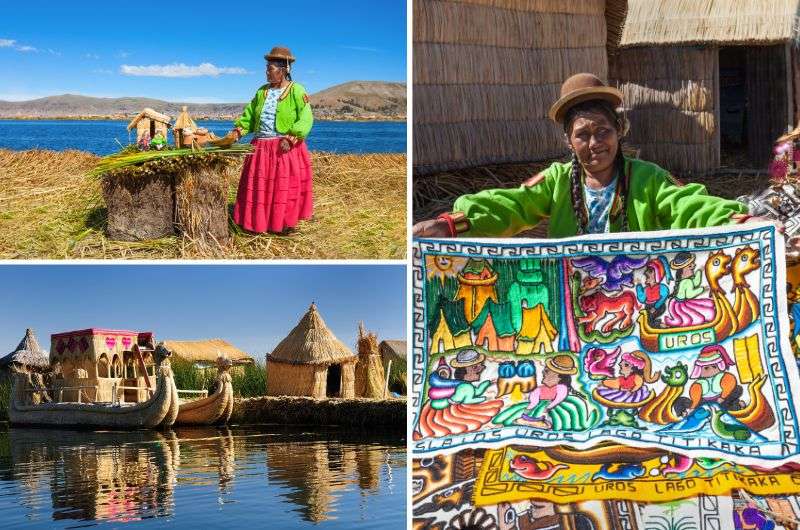
The reed everything of the Uros people
Historically, the Uros, who pre-date the Incas, weren’t able to secure land by the lake when they moved there from the mainland, so they thought “whatever, we’ll just build our own land”. The Uros Islands are built out of the reed that grows around Lake Titicaca. Seventeen reed islands, complete with reed houses and reed boats, are located on the lake.
The Uros welcome visitors on tours of the islands and sell handicrafts and reed boat trips as well (I'd always go for a private tour... guess I'm not great at sharing). Remember that the Uros only keep a small portion of whichever tour you buy in Puno, so buying things from them on the islands can help them a lot.
Short trips to the islands on Lake Titicaca start from USD 20, overnights and full-day trips cost round USD 60. If you buy an overnight tour, you will most likely be staying over on one of the natural islands with the Aymara people.
Stay in a traditional reed house on Lake Titicaca!
If you want to stay with the Uros, they will be happy to have you. There are some very basic options on their little islands, and then there’s this one: your very own bit of reed luxury, the QHAPAQ Lago Titicaca. The room is so nice, with hot water, huge windows with infinite views of Lake Titicaca, and the friendliest family taking care of you. The food here is excellent!
That wraps it up for the best day trips from Cusco. As you can see, there is tons to see, so don’t just fly through. If you have the stamina, go on at least one of the treks, they make for life-long memories.
You might also be interested in reading:
- A 3-Day Cusco Itinerary
- A 2-Week Peru Itinerary: A Day-By-Day Trip Plan
- Top 14 Handpicked Luxury Hotels in Peru (With Prices)
- The 10 Best Ruins to Visit in Peru
- Top 9 Places to See in Sacred Valley
This post contains affiliate links. I earn a small commission if you make bookings through my links, at no additional cost to you. Thank you for your support!





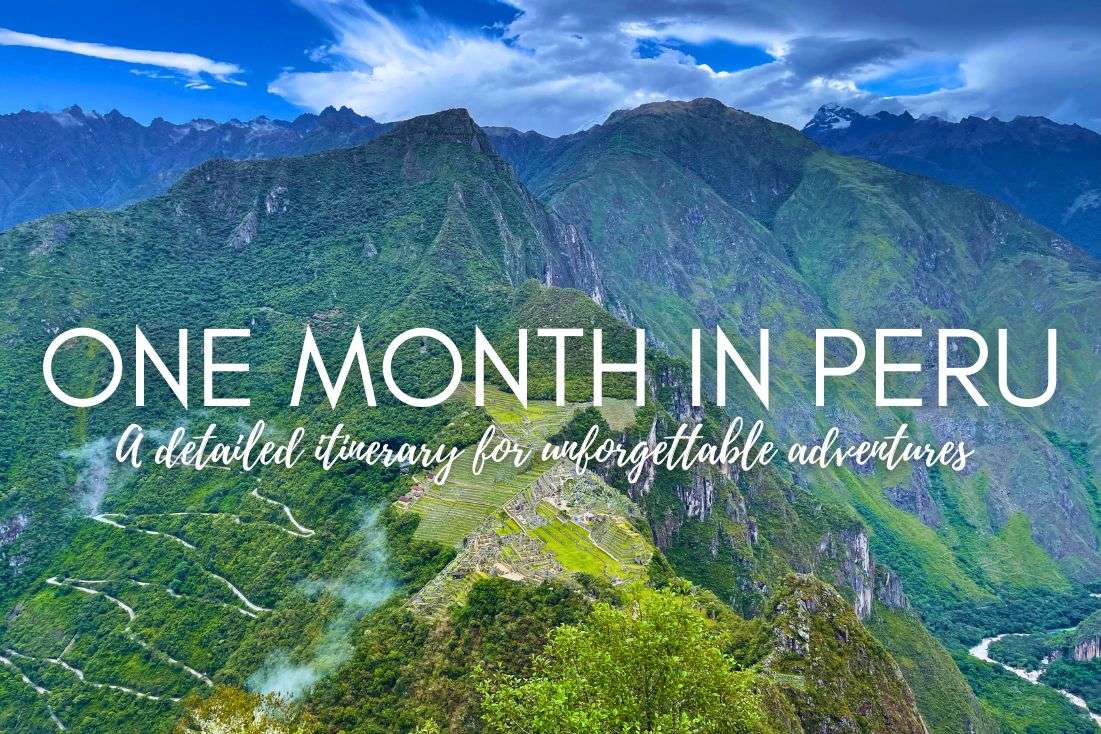
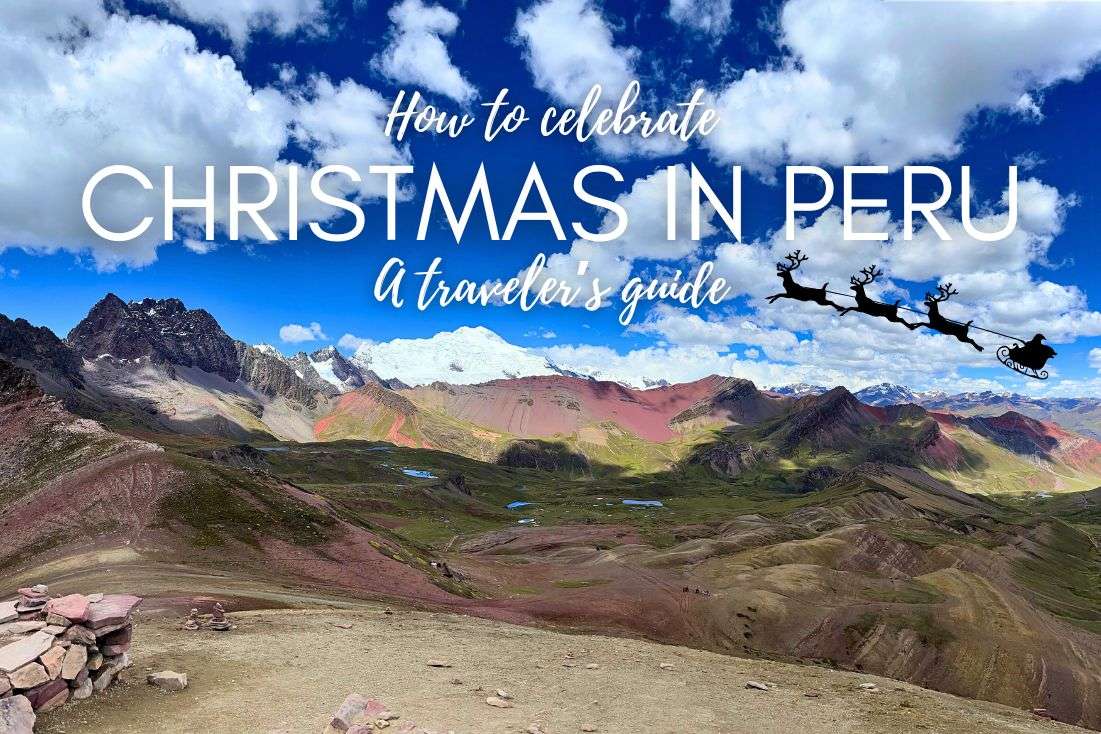



Comments | Thoughts? Give us a shout!